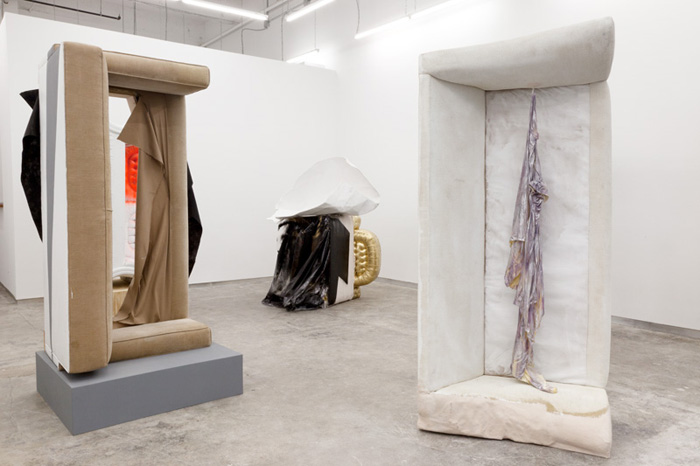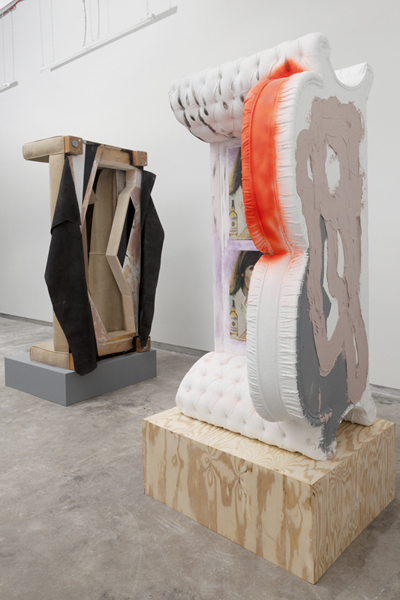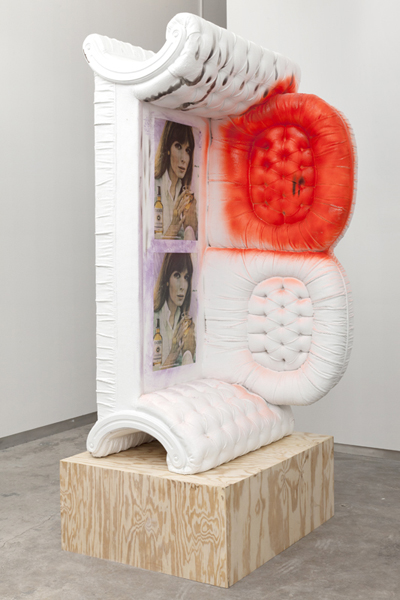
Ernesto Burgos' solo show at Kate Werble Gallery, titled the tone was a synthesis of all the voices they had ever heard, consists primarily of a group of vintage couches that have been upended and reworked into remarkably varied sculptural objects. Gutted and reconstituted with a deft oscillation between crafted wood and blunt, happenstance materials, the couches resonate as both objects and conceptual confrontations against history and material culture. Each piece also houses the specter of the couch's implied human occupant, which seemingly has been enfolded into the structure's fabric like a lost t-shirt, reverberating as a tsunami of abstraction. Quizzical and daring, Burgos' work occupies a tensely coiled line between the temporal fact of the everyday and timeless potentiality.
Can you tell us about the name of the show, "the tone was a synthesis of all the voices they had ever heard?"
The title of the show is an excerpt that I rearranged a bit from a book called Cultural Amnesia, by Clive James. In music, a tone is obtained through a combination of chords; in this case the sculptures themselves, with individual characteristics, can function as singular chords. When combining these sculptures or chords, an overall tone is hopefully created in the space, resulting from the manipulation of the pieces as well as the inherent histories associated with them.
What was the process of acquiring these couches like? The couches that you use in your exhibition evoke different styles and design periods. What sort of spirits do they conjure, as individual everyday objects, and does this affect their outcomes?
The selection of the couches, more than trying to situate them in specific periods to create a linear narrative or platform, was handled in the same way most of the things I work with are: I was visually attracted to them. Some of the qualities of individual couches led to some of the decisions leading up to their final outcome, but overall this was a reaction to decisions happening when working on other couches in my studio. This connecting of points and overlapping of things appearing and reappearing in different places is crucial. It allows for threads to be drawn between disparate ideas and unifies them or exaggerates the differences between them.
Does this exhibition feel like a radical departure from your recent practice or do you feel as though there are traces of continuity?
I don't think that this is a radical departure from previous work that I was making. However, when making this body of work I really wanted to stretch these ideas almost to a point of absurdity. I have been using everyday found objects and combining them with other forms for awhile to see what some of these combinations could do. So, I thought if I was using common and recognizable materials, why not take this idea in a ridiculous direction and see what forms I could arrive at. By inverting these sofas, literally and conceptually, they become totems, monoliths, sculpture in the round and so forth, but at some point, I still understand that they still and will always remain couches. So I do believe that a trace of continuity exists in relation to past work. I have always been interested in combining different elements in precarious situations to see what kinds of thoughts or experiences can be provoked, distancing the found object from its original form and function, but never enough to lose its integrity.

The pieces in the show seem to undergo processes of destruction and reconstruction, feeling at times as an act against more stoic materials. What was it like making these interventions?
It took me awhile to actually get going with these because as I was working on them the thought of painting or cutting couches just seemed to be the dumbest idea possible. But then again, as I moved forward, things began to happen and ideas started to grow. The idea of starting from a point of nothingness, or something seemingly unimportant, and growing from there has always been more appealing to me than illustrating or enhancing ideas that have already been established.
The symbol of the whiskey glass reappears in these works in a seemingly ad hoc manner. How does this symbol interact with the choices you've made in this show?
I have had images of these old alcohol advertisements from the 60s bouncing around my studio for a few years and have used them in all sorts of ways. The alcohol, as an idea, really was secondary. I was initially attracted to the palette of the advertisements, along with the image of the hand interacting with an object, in this case a glass. All of these images were reworked by removing any advertisement information, such as texts or logos, so as to focus on the hand interacting with the glass or object. There is a lot of humor in these because some of the gestures are completely arbitrary and you are not quite sure what is happening: perhaps pushing, receiving, lifting, covering, denying, protecting and so on. There is a religious quality to them, like a priest blessing a glass of wine, elevating its original status into something sacred. This is completely ironic and ad hoc in terms of the artist's relationship to his or her objects, whether physically, through the hand, or conceptually. In a sense, I suppose that is what we are doing, which is somewhat ridiculous.
